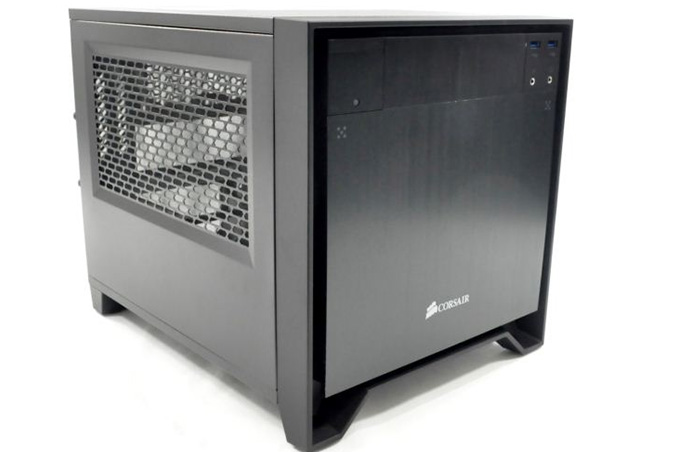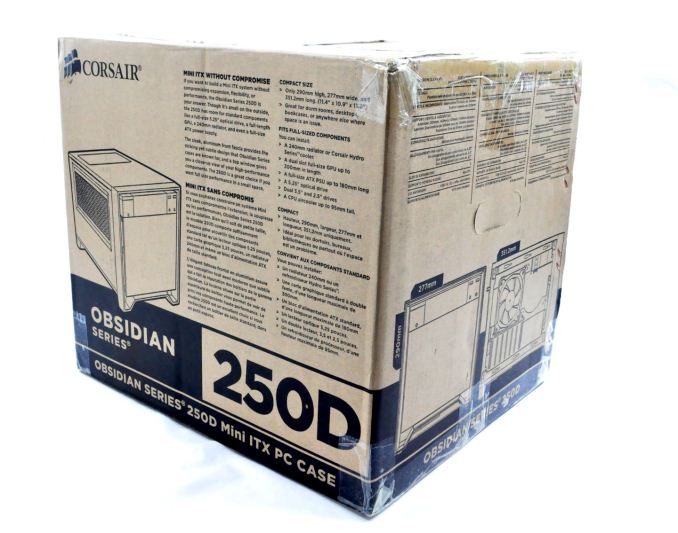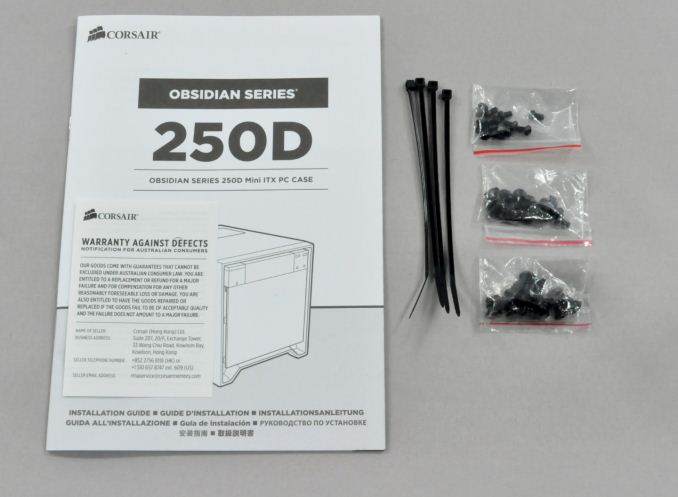Corsair Obsidian 250D Case Review
by E. Fylladitakis on January 21, 2014 12:00 PM EST- Posted in
- Cases/Cooling/PSUs
- Corsair
- Mini ITX
- Case

Ed: As this is his first review, we’d like to quickly introduce E. Fylladitakis. E. is taking over Cases & Cooling coverage as our newest editor, so this is the first of many articles you will see from him over the coming months
Corsair is a very well-known manufacturer among technology enthusiasts, and the company has been a supplier of premium memory modules for decades. During the past several years however, the company has successfully diversified into many segments of the market and today offers numerous products: computer cases, power supply units, air and liquid CPU coolers, solid-state drives, and gaming peripherals can all be found in Corsair's product ranks.
With the recent announcement of the Obsidian 250D, the company chose to start 2014 by joining the Mini ITX case fever, something most other large case designers and manufacturers have done recently. The Obsidian 250D however has not been designed with minimum proportions in mind; despite the Mini ITX format, it can still house very powerful gaming systems and advanced cooling solutions. The specifications of the case can be seen in the following table.
| Corsair Obsidian 250D | ||
| Motherboard Form Factor | Mini-ITX | |
| Drive Bays | External | 1 × 5.25" |
| Internal | 2 ×2.5" 2 × 3.5" | |
| Cooling | Front | 1×200 / 140 mm (140 mm included) |
| Rear | 2×80mm | |
| Top | - | |
| Side | 2 x 120 mm (1 × 120 mm included) | |
| Bottom | - | |
| I/O Port | 2x USB 3.0, 1x Headphone, 1x Mic | |
| Power Supply Size | ATX | |
| Clearances | HSF | ≈145 mm |
| PSU | - | |
| GPU | ≈295 mm | |
| Dimensions | 350 mm ×277 mm ×290 mm(D × W × H) | |
| Weight | ≈5kg | |
| Prominent Features | Aluminum front fascia and thick steel construction Top window for component visibility Thumbscrew backplate removal for PSU and hard drive access Easily removed dust filters on all intakes Simultaneously fit two 3.5”/2.5” drives, two 2.5” drives, one 5.25” drive, a full sized PSU, a 290mm long GPU, and a 240mm radiator Innovative three panel removal for sides and top panel, with thumbscrews Tons of cable routing tie downs for easy cable maintenance Tool free installation of all drives | |
| Price | ≈ 70 EUR / 89.99 USD | |
We received the Obsidian 250D inside a short, simple cardboard box that hints at the cubic shape of the case. Inside the box, we found the case packed between thick Styrofoam slabs and wrapped in a nylon bag, which is more than ample shipping protection for the small, lightweight case.
The bundle of the Obsidian 250D is sparse, with Corsair supplying only the absolutely necessary parts needed to fully assemble a system. We only found a manual, three small bags with black screws and a few black cable ties. At least some more cable ties and perhaps a couple of cable straps would be a nice addition. The bundle may be found in a cardboard box secured into one of the 3.5" trays.












52 Comments
View All Comments
JDG1980 - Tuesday, January 21, 2014 - link
I like the idea of using synthetic thermal loads for reliability, but I'm curious how heat is dispersed from these. Do they have metal heatsinks on them like actual components would? If so, do they have pins or fins - and if the latter, what kind of orientation? That can make a big difference - you'll get much better cooling if the airflow is parallel to the fin direction rather than perpendicular. A case with direct airflow (like the Corsair Air 540) will do very well if the video card's fins are parallel to the long side of the card, while a tower with a side fan (like the NZXT Phantom 630) will probably do better if the fins are perpendicular to the slot. How does your current setup take these things into account?E.Fyll - Tuesday, January 21, 2014 - link
Great thinking JDG1980.True, heat is dispersed via heatsinks. Even though the faux boards are solid copper sheets, their surface alone is not enough to disperse such volumes of energy. Unfortunately, they are commercial products and thus they do have fins. I could not find symmetrical heatsinks available commercially and custom constructions would cost a lot of cash. Unfortunately, that was the best I could do with my limited time and resources at this point of time, although the design will gradually improve over time.
The fins of the faux cards are parallel to the sides of the card. The fins of the Mini-ITX board are parallel to the top/bottom sides of the board.
Specifically regarding the GFX card, the design will favor cases which have a fan blowing right at them. However, cases which have no direct airflow over the card slots rely on passive/bulk airflow only, in which case the orientation of the fins would hardly matter.
To summarize, although the fins can work in the favor of some designs, the bulk airflow is far more important as the load does not in any way aids the airflow/heat dissipation capabilities of the case itself, therefore the error is not high.
dbtc - Wednesday, January 29, 2014 - link
I really like the idea behind developing a more consistent testing strategy. The problem I see is that it, although it may provide a very accurate comparison between cases in their true stock configuration, it might not be a good representation real world usage.For example, adding a single fan or changing the orientation of the CPU sink could drastically improve the performance. I think some brief results addressing optimizing the case would be extremely helpful. Not only for providing a more complete review but also for anyone interested in using the case who would like to know which types of components would work best.
I know, it's a lot of extra work - just my thoughts.
jojo32 - Tuesday, January 21, 2014 - link
Is the front of the case damaged? For me, cosmetic defects and rattling parts are so common when getting cases for a custom PC.sor - Tuesday, January 21, 2014 - link
Sort of looks like they forgot to take the protective film off of the front of the case when taking the photos.HaZaRd2K6 - Tuesday, January 21, 2014 - link
It's probably just wear and tear from the case being shipped around to various reviewers.E.Fyll - Tuesday, January 21, 2014 - link
Camera lens overexposure from the overly bright lighting. I am still waiting for a couple of light diffusers. Sorry...There actually is a small dent at the top right side of the front door, as seen in the picture displaying the I/O ports, but this case went through two custom inspections and an intercontinental three working day delivery. The box makes it clear that it has been somewhat mishandled, it has been opened/repackaged twice and the dent is right behind a thick slab of Styrofoam which was undamaged; therefore, my educated guess would be that the dent was caused by the inspectors or during shipping, rather than on the factory floor.
jojo32 - Thursday, January 23, 2014 - link
Thanks. I didn't think of lighting. Then again, I'm not a photography enthusiaist. I think my phone takes great pictures.I never had a Corsair case but cosmetic defects from manufacuturing, damage from shipping and loose parts happen so often when I bought cases from other companies (BitFenix, Cooler Master, Silverstone and Lian Li).
stratum - Monday, January 27, 2014 - link
Same here. I'm more likely to get damage, loose parts and cosmetic defects than not. Even the $100+ "premium" cases are like this.BigLeagueJammer - Tuesday, January 21, 2014 - link
I'd like more information about the new thermal testing. I thought there wasn't much information for something that's a new concept compared to putting a real system in there. Overall I found it rather confusing and borderline useless.